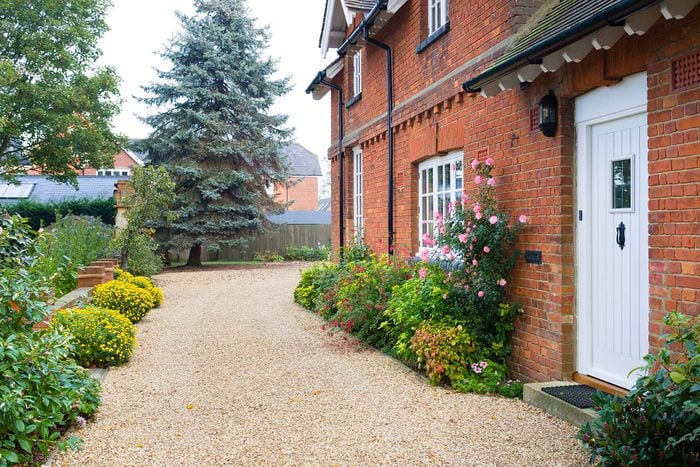What Is the Most Sustainable Type of Groundcover?
Updated: Sep. 22, 2023

Even though traditional turf grass lawns are still the go-to choice, homeowners are now shifting to more sustainable groundcover options.
Since the 1950s, plush green lawns have been a status symbol of the American dream as more people moved out to the suburbs. Today, turf grass lawns are the norm, covering an estimated 62,500 square miles across the United States — roughly the size of Florida.
Turf grass is touted for its ability to handle foot traffic. But it comes with a high cost, financially and environmentally.
It’s estimated that Americans spend $30 billion a year and endless hours caring for their lawn, according to the University of Delaware Cooperative Extension. Yet turf grass lawns have high water requirements, low wildlife value, and high pollution and public health risks due to fertilizers, pesticides and equipment use.
“The standard regimen of synthetic fertilizers, supplemental watering and cutting, trimming and blowing with gas-powered equipment are often not aligned with sustainability,” says Trista Imrich, landscape designer and horticulturist at Wild Works of Whimsy.
Given these concerns, more homeowners are looking to replace their traditional turf grass with a more sustainable groundcover that’s better for the environment and requires less maintenance.
What Makes a Groundcover Sustainable?
The most sustainable type of groundcover depends on factors like climate, soil, water needs and availability, biodiversity and intended use of the space. A sustainable groundcover usually has these characteristics:
- Requires less watering;
- Requires little or no mowing and weeding;
- Requires few or no fertilizers, herbicides and pesticides;
- Attracts pollinators and promotes biodiversity.
- Compatible with the climate, soil and wildlife.
- Improves ecological balance and health of the lawn.
Types of Groundcover
With so many types of groundcover to choose from, it can be daunting to make the switch from turf grass to something more sustainable. Here’s a list of groundcovers, ranked from most to least sustainable:
No-mow native perennial bed
The most sustainable alternative to turf grass, by far, is a no-mow native perennial bed groundcover with a mix of native plants. As perennials, they live more than two years and come back every season. These include mondo grass, white clover, mosses, lamb’s ear, black-eyed Susan and many more.
According to Zac Gnadinger, founder of the Kentucky Native Plants Project, “Native plants are adapted to local climate and soil conditions, making them a low-maintenance option that won’t require excessive watering, fertilization or pest control. They also play an essential role in supporting local ecosystems by providing habitat for native pollinators and birds.”
Plus, they improve soil quality, prevent erosion, suppress weeds and reduce pests and diseases.
If you’re having trouble deciding what to plant, check your USDA Plant Hardiness Zone and consult with a local native plant expert, gardening club, or garden center.
Wildflower meadow
You could also create a low meadow, less than about three feet high.
“Meadowscaping is creating an environment in your yard that mimics the natural growth and life of a meadow,” says Christen Costa, CEO of GR Lawn & Garden. “The space is primarily left unmaintained. It supports your native environment, and it helps attract bees and other pollinators.”
When meadowscaping, only choose plants native to your specific local environment so they can thrive with little maintenance.
According to a recent study at the University of Cambridge, a wildflower meadow is a much greener alternative to a perfectly manicured patch of grass because gardens can store carbon over time.
Researchers estimate meadows could save about 1.36 tons of carbon emissions per hectare per year, mainly by eliminating mowing and fertilizing. Previous studies also indicated even mini meadows can positively impact wildlife.
Mulch
Typically made of wood chips or bark, mulch can prevent weeds, erosion, moisture loss and fertilizer and herbicide runoff. Mulch also boosts soil health as it decomposes.
“Mulch is easy to install and maintain, as it does not require watering, mowing or fertilizing,” says Rhys Charles, a landscaper and CEO and founder of Lawn and Tractors.
However, it can be expensive to keep replacing, because as it fades, it washes away or decomposes. Also, it can attract termites, rodents or fungi if not properly treated or maintained. To maintain mulch, use a barrier, periodically turn over the top layer and pull weeds when they appear.
Gravel or stone
Gravel or stone is another alternative to turf grass. Although more expensive than other options, it requires minimal maintenance and lasts a long time. The challenge? Eventually, weeds will start to grow between the rocks.
“Also, gravel can create excess heat in the summer as it absorbs and reflects the sun,” Imrich says. “It can also reduce the infiltration of water into the soil, as it compacts the ground beneath it over time. This can increase stormwater runoff, which can carry pollutants and sediments into waterways.”
Use gravel and stone sparingly, only in walkways and between landscape — not for the entire lawn. Also ask your local supplier the source of the material, to understand its impact on the land. Try to avoid gravel mined from riverbeds, and opt for materials sourced from nearby quarries instead.
Artificial turf
Artificial turf is the least sustainable option, though it doesn’t require watering, mowing, fertilizing or pesticides. That’s because it’s made from synthetic materials like nylon, polyethylene or polypropylene, and doesn’t attract wildlife.
Kathy Jentz, author of Groundcover Revolution and host of the GardenDC Podcast, is not a fan of artificial turf. “It is plastic from the oil industry,” she says. “It kills everything in the soil below it. In the heat and hot sun, there is off-gassing of chemicals.”
She also says it still must be cleaned and vacuumed. And it decays and breaks down over time, releasing microplastics into the air and waterways.
